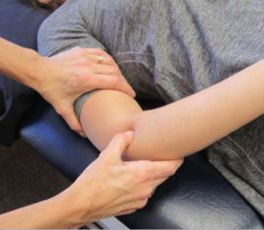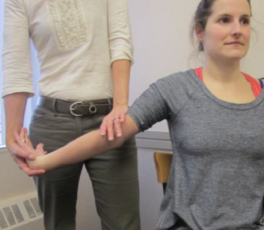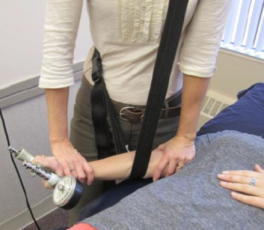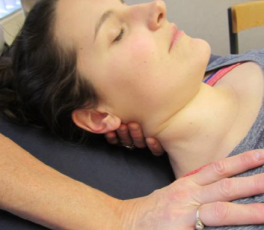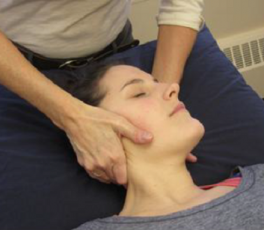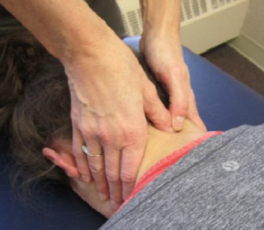Lateral Epicondyle Tendinopathy Toolkit: Section F - Manual Therapy: Difference between revisions
Evan Thomas (talk | contribs) No edit summary |
m (Protected "Lateral Epicondyle Tendinopathy Toolkit: Section F - Manual Therapy" ([Edit=⧼protect-level-ppadmin⧽] (indefinite) [Move=⧼protect-level-ppadmin⧽] (indefinite))) |
||
| (37 intermediate revisions by 7 users not shown) | |||
| Line 1: | Line 1: | ||
= | <div class="noeditbox"> | ||
This article is currently under review and may not be up to date. Please come back soon to see the finished work! ({{REVISIONDAY}}/{{REVISIONMONTH}}/{{REVISIONYEAR}}) | |||
</div> | |||
<div class="editorbox"> '''Original Editor '''- [[User:Kim Jackson|Kim Jackson]] uploaded for the BC Tendinopathy Task Force | |||
Dr. Joseph Anthony, Paul Blazey, Dr. Allison Ezzat, Dr. Angela Fearon, Diana Hughes, Carol Kennedy, Dr. Alex Scott, Michael Yates and Alison Hoens | |||
'''Top Contributors''' - {{Special:Contributors/{{FULLPAGENAME}}}} | |||
</div> | |||
==Manual Therapy== | |||
[[Manual Therapy|Manual therapy]] is a modality used in rehabilitation to assess and treat various conditions. The American Physical Therapy Association (APTA) describes manual therapy as “skilled hand movements intended to improve tissue extensibility, increase range of motion, induce relaxation, mobilize or manipulate soft tissue and joints, modulate pain, and reduce soft tissue swelling, inflammation, or restriction”. It describes hands-on techniques used in rehabilitation to treat various conditions, such as: | |||
* Massage | |||
* manual lymphatic drainage | |||
* manual traction | |||
* mobilisation/manipulation | |||
* passive range of motion | |||
< | Manual therapy is one of the oldest recorded modalities<ref>Pettman E. A history of manipulative therapy. Journal of Manual & Manipulative Therapy. 2007 Jul 1;15(3):165-74.</ref> and over the years it has seen many changes to its use and governance. It's use in the assessment and treatment of epicondylitis is often advocated<ref>Andres BM, Murrell GA. Treatment of tendinopathy: what works, what does not, and what is on the horizon. Clinical orthopaedics and related research. 2008 Jul;466(7):1539-54.</ref><ref>Landesa-Piñeiro L, Leirós-Rodríguez R. Physiotherapy treatment of lateral epicondylitis: A systematic review. Journal of back and musculoskeletal rehabilitation. 2022 Jan 1;35(3):463-77.</ref>. | ||
=== Cyriax-Type Physiotherapy Treatment === | |||
< | Cyriax and Cyriax suggested the use of deep transverse [[Friction Massage|friction massage]] in combination with mill's manipulation for the treatment of tennis elbow<ref>Cyriax HJ, Cyriax JP. ''Cyriax's Illustrated Manual of Orthopaedic Medicine''. Oxford, UK: Butterworth-Heinemann; 1983</ref>. In order to label the treatment intervention as Cyriax physiotherapy, both the treatment components mentioned above must be used jointly in the sequence specified. In this protocol, person must adhere to this intervention 3 times a week for duration of 4 weeks.<ref>Stasinopoulos D, Johnson MI. Cyriax physiotherapy for tennis elbow/lateral epicondylitis. ''British Journal of Sports Medicine''. 2004;38(6):675–677</ref> Figures 1 and 2 and the accompanying descriptions are the components of this treatment approach. | ||
< | A study by Viswas et al 2012 found that Cyriax physiotherapy was effective in reducing pain associated with LET<ref>Viswas R, Ramachandran R, Korde Anantkumar P. Comparison of effectiveness of supervised exercise program and cyriax physiotherapy in patients with tennis elbow (lateral epicondylitis): a randomized clinical trial. The Scientific World Journal. 2012.</ref> <br> | ||
<br> | |||
<div class="flex-row row"> | |||
<div class="col-md-8">'''Deep Transverse Friction Massage (DTFM)''' <br> | |||
*Patient’s elbow is supported in a 90 degrees flexion, fully supinated position. | |||
*DTFM is applied with the thumb at the common extensor tendon just anterior to the epicondyle. | |||
*Frictions were applied for 10 minutes prior to the Mill’s manipulation. | |||
</div> | |||
<div class="text-center" "col-md-4">[[Image:LET Appendix B Fig1.png|center|264x230px]] | |||
'''Figure 1''' | |||
</div> | |||
</div> | |||
<br> | |||
<div class="flex-row row"> | |||
<div class="col-md-8">'''Mill’s Manipulation''' <br> | |||
*Patient is in sitting with arm in abduction, internal rotation such that the olecranon faces upwards, forearm fully pronated and wrist in flexion. Therapist’s one hand supports the wrist flexion, the other hand placed over the olecranon. | *Patient is in sitting with arm in abduction, internal rotation such that the olecranon faces upwards, forearm fully pronated and wrist in flexion. Therapist’s one hand supports the wrist flexion, the other hand placed over the olecranon. | ||
*Maintaining this position the therapist applies a high velocity, low amplitude thrust through the olecranon. | *Maintaining this position the therapist applies a high velocity, low amplitude thrust through the olecranon. | ||
</div> | |||
<div class="text-center" "col-md-4">[[Image:LET Appendix B Fig2.png|center|264x230px]] | |||
'''Figure 2''' | |||
</div> | |||
</div> | |||
< | |||
< | |||
[[Image:LET Appendix B Fig2.png|center|264x230px]]''' | |||
<br> | <br> | ||
== Elbow Mobilization with Movement (MWM) | === Elbow Mobilization with Movement (MWM) === | ||
Mobilisations with movement is a manual therapy technique that forms part of the [[Mulligan Concept]]. MWM is the concurrent application of sustained accessory mobilization applied by a therapist and an active physiological movement to end range applied by the patient. Passive end-of-range overpressure, or stretching, is then delivered without pain as a barrier. | |||
<div class="flex-row row"> | |||
<div class="col-md-8"> | |||
*Patient is in supine with their arm by their side, elbow extended and forearm pronated. | *Patient is in supine with their arm by their side, elbow extended and forearm pronated. | ||
*A lateral glide is applied to the radius and ulna with the therapist’s hands | *A lateral glide is applied to the radius and ulna with the therapist’s hands or using a belt around the therapist’s shoulders. | ||
*The patient then either grips or extends the wrist against resistance as long as this is now pain-free. | *The patient then either grips or extends the wrist against resistance as long as this is now pain-free. | ||
*6-10 repetitions are performed in a single treatment session. | *6-10 repetitions are performed in a single treatment session.</div> | ||
<div class="text-center" "col-md-4">[[Image:LET Appendix B Fig3.png|center|264x230px]] | |||
'''Figure 3''' | |||
</div> | |||
</div> | |||
< | |||
< | |||
[[Image:LET Appendix B Fig3.png|center|264x230px | |||
<br> | <br> | ||
== Spinal Mobilization/Manipulation | === Spinal Mobilization/Manipulation === | ||
Spinal mobilization and [[Spinal Manipulation|manipulation]] are widely used techniques, where force is applied to the spinal joints, to treat pain in the extremities, [[Low Back Pain|back]], and [[Neck Pain Patient Decision Aid: Step 4|neck]]. Although the exact underlying mechanisms are not fully understood, treatment of dysfunctional areas in the spine can restore the spine’s structural integrity, reduce pain and initiate the body’s natural healing processes.<ref>Pfluegler G, Kasper J, Luedtke K. The immediate effects of passive joint mobilisation on local muscle function. A systematic review of the literature. Musculoskeletal Science and Practice. 2020 Feb 1;45:102106.</ref> | |||
<div class="flex-row row"> | |||
<div class="col-md-8"> | |||
'''Lateral Glide Mobilization (Vicenzino et al 1996<ref>Vicenzino B, Collins D, Wright A. The initial effects of a cervical spine manipulative physiotherapy treatment on the pain and dysfunction of lateral epicondylalgia. Pain. Nov 1996; 68(1): 69-74.</ref>)''' | '''Lateral Glide Mobilization (Vicenzino et al 1996<ref>Vicenzino B, Collins D, Wright A. The initial effects of a cervical spine manipulative physiotherapy treatment on the pain and dysfunction of lateral epicondylalgia. Pain. Nov 1996; 68(1): 69-74.</ref>)''' | ||
*Mobilizing hand wraps around the head and neck to the level of the C5/6 segment. | *Mobilizing hand wraps around the head and neck to the level of the C5/6 segment. | ||
*A Grade III lateral glide is applied contralateral to the effected side. | *A Grade III lateral glide is applied contralateral to the effected side. | ||
*A depression force is applied to the ipsilateral shoulder girdle.< | *A depression force is applied to the ipsilateral shoulder girdle.</div> | ||
<div class="text-center" "col-md-4">[[Image:LET Appendix B Fig4.png|center|264x230px]] | |||
'''Figure 4''' | |||
</div> | |||
</div> | |||
< | <div class="flex-row row"> | ||
<div class="col-md-8"> | |||
'''Cervical Manipulative Thrust (Fernández-Carnero et al 2008<ref>Fernández-Carnero J, Fernández-De-Las-Peñas C, et al. Immediate hypoalgesic and motor effects after a single cervical manipulation in subjects with lateral epicondylalgia. Journal of Manual & Manipulative Therapy. 2008; 31(9): 675-681.</ref>)''' | |||
<br> | *Cervical spine is locked using side flexion towards and rotation away from the side to be manipulated. | ||
*The high velocity, low amplitude thrust was directed superior and medially towards the opposite eye. | |||
< | <br> | ||
*''NOTE: This technique should only be used by those who have been instructed in its use, and only following a complete assessment of the cervical arterial system.''</div> | |||
< | <div class="text-center" "col-md-4">[[Image:LET Appendix B Fig5.png|center|264x230px]] | ||
'''Figure 5''' | |||
< | </div> | ||
</div> | |||
< | <div class="flex-row row"> | ||
<div class="col-md-8"> | |||
'''Passive Intervertebral Mobilization (Cleland et al 2005<ref name="Cleland 2005" />)''' | |||
'''Passive Intervertebral Mobilization (Cleland et al 2005<ref name="Cleland 2005" | |||
''Passive Physiological Mobilization'' | ''Passive Physiological Mobilization'' | ||
*Grade III or IV mobilization of hypomobile segment found on assessment.<br> | *Grade III or IV mobilization of the hypomobile segment found on assessment.<br></div> | ||
<div class="text-center" "col-md-4">[[Image:LET Appendix B Fig5.png|center|264x230px]] | |||
< | '''Figure 6''' | ||
</div> | |||
</div> | |||
< | |||
[[Image:LET Appendix B Fig5.png|center|264x230px | |||
<div class="flex-row row"> | |||
<div class="col-md-8"> | |||
'''Passive Intervertebral Mobilization (Cleland et al 2005<ref name="Cleland 2005">Cleland JA, Flynn TW, Palmer JA. Incorporation of manual therapy directed at the cervicothoracic spine in patients with lateral epicondylalgia: a pilot clinical trial. Journal of Manual & Manipulative Therapy. 2005; 13(3): 143-151.</ref>)''' | |||
''Passive Accessory Mobilization'' | |||
<br> | *Grade III or IV mobilization of the hypomobile segment found on assessment.<br></div> | ||
<div class="text-center" "col-md-4">[[Image:LET Appendix B Fig6.png|center|264x230px]] | |||
'''Figure 7''' | |||
</div> | |||
</div> | |||
== Supporting Evidence == | |||
There is differing evidence to support the use of manual therapy to treat LET. The evidence is summarised below; for more information, please see [[Lateral Epicondyle Tendinopathy Toolkit: Section D - Summary of the Evidence|Section D - Summary of the Evidence for Physical Therapy Interventions]]. | |||
'''Elbow Joint Mobilisations''' | |||
* Acute stage - There is minimal clinical evidence to support or refute the use of elbow mobilization in the acute stage. | |||
* Chronic stage - There is a large amount of clinical evidence supporting the use of elbow mobilizations, (MWM and Mill’s Manipulation). Moderate effect sizes are demonstrated across all timeframes (immediate, short and long term). MWM shows favorable outcomes for pain, grip strength and function. Mill’s manipulation demonstrated effectiveness for pain but not pain free grip strength. The use of Mill’s manipulation for improved function is unclear. | |||
'''Spinal Mobilization Techniques''' | |||
* Acute stage - There is minimal clinical evidence or expert opinion on the use of spinal mobilization/manipulation for patients with acute LET. | |||
* Chronic stage - Credible clinical evidence supports the use of cervical and thoracic mobilization/manipulation into the treatment of LET for improved pain, increased PPT, grip strength and function in the short-term. In one study a stronger effect was produced when delivered with a supportive and empathetic approach. Neuromobilization techniques (radial nerve) have been shown. | |||
'''Soft Tissue Techniques''' | |||
* Acute stage - Limited clinical evidence supports the use of soft tissue techniques as a stand alone treatment. | |||
* Chronic stage - There is weak clinical evidence to support the use of soft tissue techniques such as frictions, in combination with other treatment modalities. ''Note: most of the studies which examined the effect of frictions included the use of Mill’s manipulation +/-exercise.'' | |||
== Resources == | |||
| | *[[Lateral Epicondyle Tendinopathy (Tennis Elbow) Toolkit|Lateral Epicondyle Tendinopathy Toolkit page]] | ||
*[[Lateral Epicondyle Tendinopathy Toolkit: Section B - Clinical Assessment|Section B - Clinical Assessment of LET]] | |||
*[[Lateral Epicondyle Tendinopathy Toolkit: Section C - Outcome Measures|Section C - Outcome Measures]] | |||
*[[Lateral Epicondyle Tendinopathy Toolkit: Section D - Summary of the Evidence|Section D - Summary of the Evidence]] | |||
*[[Lateral Epicondyle Tendinopathy Toolkit: Section E - Exercise Prescription|Section E - Exercise Prescription]] | |||
*[[Lateral Epicondyle Tendinopathy Toolkit: Section G - LASER Dosage Calculation|Section G - LASER Dosage Calculation]] | |||
*[[Lateral Epicondyle Tendinopathy Toolkit: Section H - Braces, Splints, and Taping|Section H - Braces, Splints and Taping]] | |||
* UBC [https://physicaltherapy.med.ubc.ca/physical-therapy-knowledge-broker/lateral-epicondyle-tendinopathy-let-toolkit/ Lateral Epicondyle Tendinopathy Toolkit] | |||
<br> | <br> | ||
== References == | == References == | ||
<references /> | <references /> | ||
[[Category:Sports Medicine]] | |||
[[Category:Sports Injuries]] | |||
[[Category:Elbow]] | |||
[[Category:Tendinopathy]] | |||
[[Category:Interventions]] | |||
[[Category:Elbow - Interventions]] | |||
[[Category:Clinical Guidelines]] | |||
[[Category:Elbow - Guidelines]] | |||
[[Category:PT Knowledge Broker Project]] | |||
Latest revision as of 17:24, 1 December 2022
This article is currently under review and may not be up to date. Please come back soon to see the finished work! (1/12/2022)
Dr. Joseph Anthony, Paul Blazey, Dr. Allison Ezzat, Dr. Angela Fearon, Diana Hughes, Carol Kennedy, Dr. Alex Scott, Michael Yates and Alison Hoens
Top Contributors - Evan Thomas, Kim Jackson, Wanda van Niekerk, Rishika Babburu, Admin, Vidya Acharya and 127.0.0.1
Manual Therapy[edit | edit source]
Manual therapy is a modality used in rehabilitation to assess and treat various conditions. The American Physical Therapy Association (APTA) describes manual therapy as “skilled hand movements intended to improve tissue extensibility, increase range of motion, induce relaxation, mobilize or manipulate soft tissue and joints, modulate pain, and reduce soft tissue swelling, inflammation, or restriction”. It describes hands-on techniques used in rehabilitation to treat various conditions, such as:
- Massage
- manual lymphatic drainage
- manual traction
- mobilisation/manipulation
- passive range of motion
Manual therapy is one of the oldest recorded modalities[1] and over the years it has seen many changes to its use and governance. It's use in the assessment and treatment of epicondylitis is often advocated[2][3].
Cyriax-Type Physiotherapy Treatment[edit | edit source]
Cyriax and Cyriax suggested the use of deep transverse friction massage in combination with mill's manipulation for the treatment of tennis elbow[4]. In order to label the treatment intervention as Cyriax physiotherapy, both the treatment components mentioned above must be used jointly in the sequence specified. In this protocol, person must adhere to this intervention 3 times a week for duration of 4 weeks.[5] Figures 1 and 2 and the accompanying descriptions are the components of this treatment approach.
A study by Viswas et al 2012 found that Cyriax physiotherapy was effective in reducing pain associated with LET[6]
- Patient’s elbow is supported in a 90 degrees flexion, fully supinated position.
- DTFM is applied with the thumb at the common extensor tendon just anterior to the epicondyle.
- Frictions were applied for 10 minutes prior to the Mill’s manipulation.
- Patient is in sitting with arm in abduction, internal rotation such that the olecranon faces upwards, forearm fully pronated and wrist in flexion. Therapist’s one hand supports the wrist flexion, the other hand placed over the olecranon.
- Maintaining this position the therapist applies a high velocity, low amplitude thrust through the olecranon.
Elbow Mobilization with Movement (MWM)[edit | edit source]
Mobilisations with movement is a manual therapy technique that forms part of the Mulligan Concept. MWM is the concurrent application of sustained accessory mobilization applied by a therapist and an active physiological movement to end range applied by the patient. Passive end-of-range overpressure, or stretching, is then delivered without pain as a barrier.
- Patient is in supine with their arm by their side, elbow extended and forearm pronated.
- A lateral glide is applied to the radius and ulna with the therapist’s hands or using a belt around the therapist’s shoulders.
- The patient then either grips or extends the wrist against resistance as long as this is now pain-free.
- 6-10 repetitions are performed in a single treatment session.
Spinal Mobilization/Manipulation[edit | edit source]
Spinal mobilization and manipulation are widely used techniques, where force is applied to the spinal joints, to treat pain in the extremities, back, and neck. Although the exact underlying mechanisms are not fully understood, treatment of dysfunctional areas in the spine can restore the spine’s structural integrity, reduce pain and initiate the body’s natural healing processes.[7]
Lateral Glide Mobilization (Vicenzino et al 1996[8])
- Mobilizing hand wraps around the head and neck to the level of the C5/6 segment.
- A Grade III lateral glide is applied contralateral to the effected side.
- A depression force is applied to the ipsilateral shoulder girdle.
Cervical Manipulative Thrust (Fernández-Carnero et al 2008[9])
- Cervical spine is locked using side flexion towards and rotation away from the side to be manipulated.
- The high velocity, low amplitude thrust was directed superior and medially towards the opposite eye.
- NOTE: This technique should only be used by those who have been instructed in its use, and only following a complete assessment of the cervical arterial system.
Passive Intervertebral Mobilization (Cleland et al 2005[10])
Passive Physiological Mobilization
- Grade III or IV mobilization of the hypomobile segment found on assessment.
Passive Intervertebral Mobilization (Cleland et al 2005[10])
Passive Accessory Mobilization
- Grade III or IV mobilization of the hypomobile segment found on assessment.
Supporting Evidence[edit | edit source]
There is differing evidence to support the use of manual therapy to treat LET. The evidence is summarised below; for more information, please see Section D - Summary of the Evidence for Physical Therapy Interventions.
Elbow Joint Mobilisations
- Acute stage - There is minimal clinical evidence to support or refute the use of elbow mobilization in the acute stage.
- Chronic stage - There is a large amount of clinical evidence supporting the use of elbow mobilizations, (MWM and Mill’s Manipulation). Moderate effect sizes are demonstrated across all timeframes (immediate, short and long term). MWM shows favorable outcomes for pain, grip strength and function. Mill’s manipulation demonstrated effectiveness for pain but not pain free grip strength. The use of Mill’s manipulation for improved function is unclear.
Spinal Mobilization Techniques
- Acute stage - There is minimal clinical evidence or expert opinion on the use of spinal mobilization/manipulation for patients with acute LET.
- Chronic stage - Credible clinical evidence supports the use of cervical and thoracic mobilization/manipulation into the treatment of LET for improved pain, increased PPT, grip strength and function in the short-term. In one study a stronger effect was produced when delivered with a supportive and empathetic approach. Neuromobilization techniques (radial nerve) have been shown.
Soft Tissue Techniques
- Acute stage - Limited clinical evidence supports the use of soft tissue techniques as a stand alone treatment.
- Chronic stage - There is weak clinical evidence to support the use of soft tissue techniques such as frictions, in combination with other treatment modalities. Note: most of the studies which examined the effect of frictions included the use of Mill’s manipulation +/-exercise.
Resources[edit | edit source]
- Lateral Epicondyle Tendinopathy Toolkit page
- Section B - Clinical Assessment of LET
- Section C - Outcome Measures
- Section D - Summary of the Evidence
- Section E - Exercise Prescription
- Section G - LASER Dosage Calculation
- Section H - Braces, Splints and Taping
- UBC Lateral Epicondyle Tendinopathy Toolkit
References[edit | edit source]
- ↑ Pettman E. A history of manipulative therapy. Journal of Manual & Manipulative Therapy. 2007 Jul 1;15(3):165-74.
- ↑ Andres BM, Murrell GA. Treatment of tendinopathy: what works, what does not, and what is on the horizon. Clinical orthopaedics and related research. 2008 Jul;466(7):1539-54.
- ↑ Landesa-Piñeiro L, Leirós-Rodríguez R. Physiotherapy treatment of lateral epicondylitis: A systematic review. Journal of back and musculoskeletal rehabilitation. 2022 Jan 1;35(3):463-77.
- ↑ Cyriax HJ, Cyriax JP. Cyriax's Illustrated Manual of Orthopaedic Medicine. Oxford, UK: Butterworth-Heinemann; 1983
- ↑ Stasinopoulos D, Johnson MI. Cyriax physiotherapy for tennis elbow/lateral epicondylitis. British Journal of Sports Medicine. 2004;38(6):675–677
- ↑ Viswas R, Ramachandran R, Korde Anantkumar P. Comparison of effectiveness of supervised exercise program and cyriax physiotherapy in patients with tennis elbow (lateral epicondylitis): a randomized clinical trial. The Scientific World Journal. 2012.
- ↑ Pfluegler G, Kasper J, Luedtke K. The immediate effects of passive joint mobilisation on local muscle function. A systematic review of the literature. Musculoskeletal Science and Practice. 2020 Feb 1;45:102106.
- ↑ Vicenzino B, Collins D, Wright A. The initial effects of a cervical spine manipulative physiotherapy treatment on the pain and dysfunction of lateral epicondylalgia. Pain. Nov 1996; 68(1): 69-74.
- ↑ Fernández-Carnero J, Fernández-De-Las-Peñas C, et al. Immediate hypoalgesic and motor effects after a single cervical manipulation in subjects with lateral epicondylalgia. Journal of Manual & Manipulative Therapy. 2008; 31(9): 675-681.
- ↑ 10.0 10.1 Cleland JA, Flynn TW, Palmer JA. Incorporation of manual therapy directed at the cervicothoracic spine in patients with lateral epicondylalgia: a pilot clinical trial. Journal of Manual & Manipulative Therapy. 2005; 13(3): 143-151.
